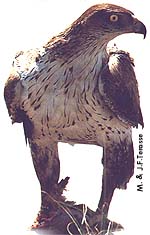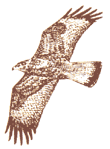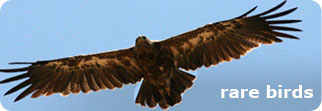 Bonelli's Eagle (Hieraaetus fasciatus) is a medium sized eagle (65-72 cm), with a wingspan of 150-180 cm, living in Europe only near the Mediterranean. Its world distribution extends from NW Africa and the Iberian peninsula east to N Indochina and S China.
Bonelli's Eagle (Hieraaetus fasciatus) is a medium sized eagle (65-72 cm), with a wingspan of 150-180 cm, living in Europe only near the Mediterranean. Its world distribution extends from NW Africa and the Iberian peninsula east to N Indochina and S China.
Bonelli's Eagles occur in mountainous areas of low and medium height (up to 1,500 m), rarely higher. They are mainly found in warm rocky mountainous regions with extended scrub (maquis, phrygana), and less frequently in woodland, but also in bare slopes with no vegetation. They use most of the habitats for hunting, besides closed woodland and desert, and they breed in steep rocks and rarely in trees.
Every pair builds several nests (1-6), close to each other (even on the same rock), which are used consecutively. The nests become larger and larger each year, up to 1,80 m in height and 2 m in diameter.
Breeding birds are sedentary, while juvenile and immature, at least in SW Europe, scatter to low altitude regions with high food density, where there are no adult birds.
It feeds on medium sized mammals, mainly rabbits and partridges, but also on hares, squirrels, rodents, doves, corvids, gulls and reptiles, caught on the ground but also on air.
Bonelli's Eagle is not a globally threatened species (IUCN), while BirdLife International classifies it as a European threatened species (Tucker and Heath 1994). In Greece, it is listed as Vulnerable in the Greek Red Book.
 It is a rare species, with an irregular distribution in the Mediterranean. Its European population, estimated at fewer than 1,000 pairs, has seriously declined. Especially for the period 1980-90, there is a 25% reduction of its numbers in Spain, where 75% of the European population is found.
It is a rare species, with an irregular distribution in the Mediterranean. Its European population, estimated at fewer than 1,000 pairs, has seriously declined. Especially for the period 1980-90, there is a 25% reduction of its numbers in Spain, where 75% of the European population is found.
The most serious threats for the Bonelli's Eagles in Europe are hunting, collision of juvenile and immatures on electric wires, the expansion of human presence as well as food reduction.
The most significant threat, however, is the change of land use and the abandonment of traditional agricultural exploitations, that has overthrown the equilibrium of the Mediterranean landscape ("habitat mosaic") either by natural reforestation, or through new agricultural practices. The result is the shrinkage of biodiversity and, consequently, suitable prey for Bonelli's Eagles.
The population of Bonelli's Eagle in Greece, according to HOS’ data from the revision of IBAs, is estimated at 85-105 pairs. Over 50% of these occur in Crete and the islands (a feature of Greece in relation to Western Europe), while the rest are distributed in the greatest part of mainland and more specifically in the coastal Mediterranean zone.
There are indications of a small decline (probably local extinctions) but the distribution of Bonelli's Eagle in Greece seems to remain stable, except for Northern and Central mainland Greece, where there is a decline.
The main known threats for this species in our country are hunting, habitat destruction (quarries, house building etc), disturbance in nesting sites (growth of tourism), road opening which makes habitats more accessible for poachers and probably food shortage in certain places. Moreover, in many areas Bonelli's Eagle is - unduly - considered to be a threat for newborn lambs and is hunted.
For the better knowledge of the status and the threats that Bonelli's Eagles are facing in Greece, a regular census and population monitoring should be done, for the prevention of possible destructive actions near nesting sites.
Moreover, studies of its ecology should be conducted and the features of the islands’ population must be investigated. With the obtained knowledge, we will be able to proceed to careful management and protection per area as well as to inform residents and hunters in the areas where it occurs.


 Bonelli's Eagle (Hieraaetus fasciatus) is a medium sized eagle (65-72 cm), with a wingspan of 150-180 cm, living in Europe only near the Mediterranean. Its world distribution extends from NW Africa and the Iberian peninsula east to N Indochina and S China.
Bonelli's Eagle (Hieraaetus fasciatus) is a medium sized eagle (65-72 cm), with a wingspan of 150-180 cm, living in Europe only near the Mediterranean. Its world distribution extends from NW Africa and the Iberian peninsula east to N Indochina and S China. It is a rare species, with an irregular distribution in the Mediterranean. Its European population, estimated at fewer than 1,000 pairs, has seriously declined. Especially for the period 1980-90, there is a 25% reduction of its numbers in Spain, where 75% of the European population is found.
It is a rare species, with an irregular distribution in the Mediterranean. Its European population, estimated at fewer than 1,000 pairs, has seriously declined. Especially for the period 1980-90, there is a 25% reduction of its numbers in Spain, where 75% of the European population is found.
